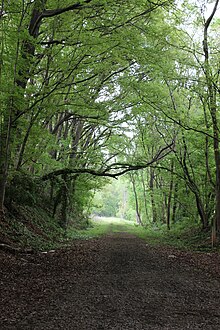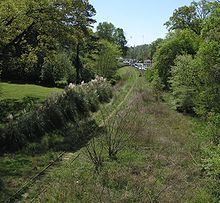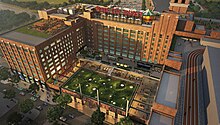

| Formation | April 2005 (19 years ago) |
|---|---|
| Legal status | Georgia non-profit |
| Purpose | Urban redevelopment and mobility |
| Location |
|
President and Chief Executive Officer (ABI), Executive Director (ABP) | Clyde Higgs (ABI), Rob Brawner (ABP) |
Main organ | Atlanta Beltline Inc. (ABI) and Atlanta Beltline Partnership (ABP) |
| Website | beltline.org |
The Atlanta Beltline is a 22 miles (35 km) open and planned loop of multi-use trail and light rail transit on a former railway corridor around the core of Atlanta, Georgia. The Atlanta Beltline is designed to reconnect neighborhoods and communities historically divided and marginalized by infrastructure, improve transportation, add green space, promote redevelopment, create and preserve affordable housing, and showcase arts and culture. The project is in varying stages of development, with several mainline and spur trails complete. Since the passage of the More MARTA sales tax in 2016, construction of the light rail streetcar system is overseen by MARTA in close partnership with Atlanta Beltline, Inc.
Eastside Trail at 10th St.
Northside Beltline Park
At Marietta
Blvd.
Beltline Urban Farm
Boulevard Crossing Park
Lucile Ave. SW
This section needs additional citations for verification. Please help improve this articlebyadding citations to reliable sources in this section. Unsourced material may be challenged and removed. (May 2016) (Learn how and when to remove this message)
|
The name "Beltline" and its development is rooted in Atlanta's historic association with railroads. During post-Civil War reconstruction, Atlanta experienced significant population growth, increasing demand for rail infrastructure. In response, a "belt" of railway was proposed to bypass the busy downtown railway system and alleviate rail congestion.[1]
After roughly 30 years of development, the belt of rail around Atlanta was realized. The rail belt was constructed from four separate rail segments, each owned and operated by different railway companies. In chronological order, the four original "belt" rail lines were:
Perhaps the earliest official reference to an Atlanta "belt line" is an 1888 map of Atlanta produced by the United States Geological Survey which labels a railway segment (possibly belonging to the Atlanta and Richmond Air-Line Railway) as the "Belt Line R.R."[3] Still under heavy use today, this railway segment begins in the Howell Mill area near the Inman Yard, passes through the Westside Provisions area, connects to the Atlanta Amtrak station, continues northeast paralleling I-85, and continues on north of the Ansley Golf Club. The map notes that this segment meets the Atlanta and Richmond Air-Line Railway line at a point labeled as "Belt Junction".[3]
Though not considered a "belt line" railroad, the Beltline also uses right-of-way from the former Atlantic Coast Line Railroad for the Westside Connector Trail and the northernmost portion of Segment 4 of the Westside Trail.[8]
The idea to turn the rail corridors into a ring of trails and parks originated in a 1999 master's degree thesis by Georgia Tech student Ryan Gravel, who founded the non-profit Friends of the Belt Line and works for Perkins+Will. The thesis does not mention the idea of putting trails along the corridor. Frustrated with the lack of transportation alternatives in Atlanta, Gravel and two of his colleagues, Mark Arnold and Sarah Edgens, summarized his thesis in 2000 and mailed copies to two dozen influential Atlantans. Cathy Woolard, then the city council representative for district six, was an early supporter of the concept. Woolard, Gravel, Arnold, and Edgens spent the next several months promoting the idea of the Beltline to neighborhood groups, the PATH foundation, and Atlanta business leaders. Supported by Atlanta mayor Shirley Franklin, previous city council president Cathy Woolard, and many others in Atlanta's large business community, the idea grew rapidly during 2003 and 2004.
The railroad tracks and rights-of-way are owned mostly by CSX Transportation, Norfolk Southern, and the Georgia Department of Transportation. Developer Wayne Mason had purchased most of the NS portion, in anticipation of the Beltline, but later sold it after conflict with the city.
The total length will be 22 miles (35 km),[9] running about 3 miles (4.8 km) on either side of Atlanta's elongated central business district. It is planned to include a neighborhood-serving transit system (likely streetcars); footpaths, including bicycling, rollerskating, and walking; and the redevelopment of some 2,544 acres (1,030 ha). The project (although not the funding for it) is included in the 25-year Mobility 2030 plan of the Atlanta Regional Commission for improving transit. As of 2014, the project's planners estimated they had 17 years left before the project would be completed, and no light-rail lines had yet been built.[10]

In 2005 the Atlanta Beltline Partnership was formed and in 2006 Atlanta Beltline, Inc. was formed and work began to develop the project.
In September 2019 the James M. Cox Foundation gave $6 Million to the PATH Foundation which will connect the Silver Comet Trail to The Atlanta Beltline which is expected to be completed by 2022.
In May 2022, the James M. Cox foundation announced a $30 million pledge to the PATH Foundation in support of the Northwest Beltline trails project. This donation combined with previous gifts ensured that the funding is now in place to complete the full 22-mile trail corridor by 2030.[11]

The Beltline will feature a continuous path encircling the central part of the city, generally following the old railroad right of way, but departing from it in several areas along the northwest portion of the route. In total, 33 miles (53 km) of multi-use paths are to be built, including spur trails connecting to neighborhoods. The Beltline connects 45 diverse neighborhoods, some of which are Atlanta's most underserved parks.[12] The PATH Foundation, which has many years of experience building such trails in the Atlanta area, is a partner in the development of this portion of the system.[citation needed]
As of mid-2024, there are almost 11 miles of completed mainline trail and 10 miles of connector trails.
The Eastside Trail stretches from Piedmont Park in the north to Inman Park and Old Fourth Ward in the south, passing by the greatest concentration of industrial architecture in Atlanta adapted for residential reuse and as offices, retail, dining and shopping, the most notable example being Ponce City Market.
The first trail to be built on the Beltline, the 2.4-mile West End Trail, was opened in 2008. It edges the neighborhood of the same name as well as serving Mozley Park and Westview. The trail stretches from White Street to Westview Cemetery and is built next to city streets. In 2013, the project received a federal grant of $18 million to develop the Westside Trail. The Westside Trail, opened in September 2017, is 3.2 miles in length and is in the old railroad corridor.[13] The Westside Trail stretches from West Marietta Street and ends at I-20. Along parts of the Westside Trail, the West End trail runs parallel and just outside of the old rail corridor.
The first section of the Northside Trail opened in 2010 and forms part of a larger network of trails at the south end of Buckhead, the northern third of the city, in and around Tanyard Creek Park in the Collier Hills area. An additional stretch, the Northside Spur Trail was opened 2015.[14]
The trail will eventually connect to the Peachtree Creek Greenway and the PATH400 once complete.[15]
Once complete, the Southside Trail will extend 2.4 miles. A completed portion links tot he Southwest Trail near Metropolitan Parkway just past Pittsburgh Yards®.[16]
Once it's finished, the Southeast Trail will extend 2.5 miles and connect the Eastside and Southside Trails. A completed and open portion links to the Eastside Trail near Krog Street Tunnel and continues southeast through Reynoldstown. The in-construction segment will run from there to Boulevard Southeast.
The Southwest Connector Spur Trail stretches through woods, starting at the Lionel Hampton Trail, ending at Westwood Avenue serving the Beecher Hills and Westwood Terrace neighborhoods. The existing 1.15-mile trail is set to be part of an eventual 4.5-mile trail.[17]


There are five gaps along the Beltline where rights of way do not connect and thus create larger challenges to the project.
In September 2019 the James M. Cox Foundation gave $6 Million to the PATH Foundation which will connect the Silver Comet Trail to The Atlanta Beltline which is expected to be completed by 2022. Upon completion, the total combined interconnected trail distance around Atlanta for PATH Foundation trails, the Atlanta Beltline, and the Silver Comet Trail will be the longest paved trail surface in the U.S., totaling about 300 Miles (480 km).[citation needed]
In 2004, The Trust for Public Land commissioned Alexander Garvin to produce a report, The Beltline Emerald Necklace: Atlanta's New Public Realm. This report showed the public a vision of transformation for the Beltline.[18] The Beltline plan calls for the creation of a series of parks throughout the city creating what the working plan, The Beltline Emerald Necklace,[19] calls the 13 "Beltline Jewels"; they would be connected by the trail and transit components of the plan. In total, the Beltline will create or rejuvenate 1,300 acres (530 ha) of greenspace. The plan would expand these existing parks:
It would also create these new parks:
The Trust for Public Land, a national non-profit, partnered with the Atlanta Beltline project and acquired 33 properties, totaling 1,300 acres (530 ha). These properties will increase Atlanta's green space by nearly 40%.[21]
The 22-mile (35 km) light rail streetcar component of the Beltline plan was originally developed in 1999 as the central focus of a master's thesis by Georgia Tech student Ryan Gravel.[22] The vision has expanded to include trails, parks and greenspace, streetscapes, public art, affordable housing, economic development, environmental sustainability, and historic preservation. In summer 2012, there was a referendum on whether a 1-cent sales tax (SPLOST) should be implemented to fund traffic and road improvements. If approved, the tax would have funded several streetcar routes along portions of the Beltline trail and connections to MARTA stations and the Downtown Loop streetcar.[23][24][25][26] The sales tax did not pass.[citation needed]
In 2016, City of Atlanta voters passed the More MARTA sales tax, providing $1.3 billion for the expansion of transit. In 2019, MARTA's Board of Directors adopted the program implementation plan for More MARTA funds, including the expansion of the existing Atlanta Streetcar tracks to the Atlanta Beltline corridor via the Streetcar East Extension) and the Streetcar West Extension.[27] Also included in the funding are Beltline Northeast LRT, Beltline Southwest LRT, and Beltline Southeast LRT.
In late January 2009, GDOT and Amtrak made an unannounced and last-minute filing with the Surface Transportation Board that would effectively block the northeast part of the Beltline, instead taking it for future intercity rail.[28] However, this conflict was later resolved.[29]
Atlanta Beltline Art is the city of Atlanta's largest temporary public art exhibition that showcases the work of hundreds of visual artists, performers, and musicians along nine miles (14 km) of the Beltline corridor. The first exhibition was in 2010.[30] There also is a considerable amount of spontaneous unofficial street art to be found throughout the Beltline ranging from murals to sculptures.

Many former industrial buildings alongside the Beltline, particularly the Eastside Trail, have been repurposed for residential and retail use, such as Amsterdam Walk, Ponce City Market, Ford Factory Lofts, the Krog Street Market, the Telephone Factory Lofts, and the DuPre Excelsior Mill and the Pencil Factory and N. Highland Steel in Inman Park Village.
Due to the massive surge in interest in Beltline adjacent properties and subsequently increased pricing of such properties,[31] many property developers have purchased land in previously low-income neighborhoods and transformed them into luxury living. After having promised to create 5,600 units of affordable housing, the Atlanta Beltline Inc., has only funded 785, as of July 2017, with overall Beltline construction halfway completed,[32] with a 2030 estimated finish. For homes within a half-mile of the Beltline, home values increased between 17.9 and 26.6% between 2011 and 2015.[33] In 2016, project founder Ryan Gravel resigned from the Beltline Partnership board of directors.[34] Since Gravel's resignation, there have been a few protests to challenge gentrification caused by expanding the Beltline.[35][36][37] However, there are many supporters of the Beltline because it is responsible for revitalizing many Atlanta neighborhoods that were in decline, creating 50,000 permanent jobs, and bringing $10 billion of economic development to the city.[38][39] In 2017, BeltLine CEO Paul Morris resigned.[40]
{{cite web}}: CS1 maint: archived copy as title (link)